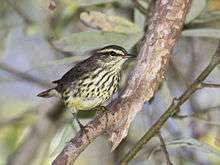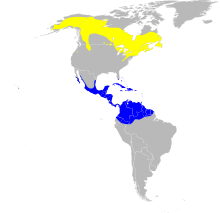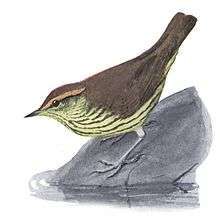Northern waterthrush
| Northern waterthrush | |
|---|---|
 | |
| Scientific classification | |
| Kingdom: | Animalia |
| Phylum: | Chordata |
| Class: | Aves |
| Order: | Passeriformes |
| Family: | Parulidae |
| Genus: | Parkesia |
| Species: | P. noveboracensis |
| Binomial name | |
| Parkesia noveboracensis (Gmelin, 1789) | |
 | |
| Range of P. noveboracensis Breeding range Wintering range | |
| Synonyms | |
|
Seiurus noveboracensis | |
The northern waterthrush (Parkesia noveboracensis[2]) is one of the larger New World warblers and one of the Nearctic-Neotropical migratory songbirds.[3] It breeds in the northern part of North America in Canada and the northern United States including Alaska. This bird is migratory, wintering in Central America, the West Indies and Florida, as well as in Venezuela, Colombia, and Ecuador. It is a very rare vagrant to other South American countries and to western Europe.
Etymology
The genus name Parkesia commemorates Kenneth Carroll Parkes, American ornithologist and curator of the Carnegie Museums of Pittsburgh, and noveboracensis is New York, the type locality from Latin novus, "new" and Eboracum, York.[4]
Description

The northern waterthrush is a large New World warbler (and not a thrush, despite the name). It has a length of 12–15 cm (4.7–5.9 in), wingspan of 21–24 cm (8.3–9.4 in) and weighs between 13 and 25 g (0.46 and 0.88 oz)[5][6] Among standard measurements, the wing chord is 6.8 to 8.2 cm (2.7 to 3.2 in), the tail is 4.5 to 5.7 cm (1.8 to 2.2 in), the bill is 1.1 to 1.2 cm (0.43 to 0.47 in) and the tarsus is 1.9 to 2.3 cm (0.75 to 0.91 in).[7] On the head, the crown is brown with a white supercilium. The bill is pointed and dark. The throat is lightly streaked brown to black with heavier streaking continuing onto the breast and flanks. The back is evenly brown. Sexes are morphologically similar. Young birds have buff, rather than white underparts.
The only species bird watchers confuse with the northern waterthrush is the closely related Louisiana waterthrush (Parkesia motacilla[2]), which has buff flanks, a buff undertail, and bright pink legs. The Louisiana waterthrush also has a whiter throat with fewer streaks. More subtle clues include smaller size and smaller bill, a narrower and darker eye-line, and different call note and habits.[8]
Both waterthrush species walk rather than hop, and seem to teeter, since they bob their rear ends as they move along.
Behavior
On the wintering grounds in Puerto Rico, northern waterthrushes leave daytime foraging areas and fly up to 2 km (1.2 mi) to nighttime roosts. The roosts are often located in red mangrove habitats.[9] Northern waterthrushes winter in 4 main habitats in Puerto Rico: white mangrove, red mangrove, black mangrove, and scrub. Males, which are larger and migrate earlier in spring, prefer to winter in white mangrove, and are able to maintain or gain weight through the winter. Females winter in the other drier and less food-rich habitats.
Waterthrushes wintering in red and black mangrove can maintain body weight through the winter but lose weight in scrub. Another determinant in body mass increase in the wintering grounds is moisture.[10]
.jpg)
Reproduction
The breeding habitat of the northern waterthrush is wet woodlands near water. It nests in a stump or among tree roots where it lays three to six eggs, cream- or buff-colored, with brown and gray spots. These eggs are laid in a cup nest constructed of leaves, bark strips, and rootlets.
Diet
The northern waterthrush is a terrestrial ground feeder,[3] eating insects, mollusks, and crustaceans found amongst leaf litter.
Vocalization
The song of loud, empathic, clear chirping notes genrally falling in pitch and accelerating; loosely paired or tripled, with little variation. Call a loud, hard spwik rising with a strong K sound. The flight call is a buzzy, high, slightly rising zzip.[8]
References
- ↑ BirdLife International (2012). "Parkesia noveboracensis". IUCN Red List of Threatened Species. Version 2013.2. International Union for Conservation of Nature. Retrieved 26 November 2013.
- 1 2 R. Terry Chesser; Richard C. Banks; F. Keith Barker; Carla Cicero; Jon L. Dunn; Andrew W. Kratter; Kirby J. Lovette; Pamela C. Ramussen; J. V. Remsen Jr.; James D. Rising; Douglas F. Stotz & Kevin Winker (2010). "Fifty-First Supplement to the American Ornithologists' Union Check-List of North American Birds" (PDF). The Auk. 127 (3): 726–744. doi:10.1525/auk.2010.127.4.966.
- 1 2 Smith, Joseph A. M.; Reitsma, Leonard R.; Rockwood, Larry L.; Marra, Peter P. (2008-07-01). "Roosting behavior of a Neotropical migrant songbird, the northern waterthrush Seiurus noveboracensis, during the non-breeding season". Journal of Avian Biology. 39 (4): 460–465. ISSN 1600-048X. doi:10.1111/j.0908-8857.2008.04227.x.
- ↑ Jobling, James A. (2010). The Helm Dictionary of Scientific Bird Names. London, United Kingdom: Christopher Helm. pp. 276, 292. ISBN 978-1-4081-2501-4.
- ↑ Eaton, S. W. (1995). "Northern Waterthrush (Parkesia noveboracensis), The Birds of North America Online". Ithaca, NY: Cornell Lab of Ornithology. Retrieved 2008-04-16.
- ↑ "FieldGuides: Northern Waterthrush Species Detail". eNature.com. Retrieved 2012-08-24.
- ↑ Curson, Jon; Quinn, David; Beadle, David (1994). New World Warblers: An Identification Guide. Christopher Helm Publishers. ISBN 0-7136-3932-6.
- 1 2 Sibley, David (2000). The Sibley Gide of Birds. New York: Alfred A. Knopf. p. 449.
- ↑ Smith, J. A. M.; Reitsma, L. R.; Rockwood, L. L. & Marra, P. P. (2008). "Roosting behavior of a Neotropical migrant songbird, the northern waterthrush Seiurus noveboracensis, during the non-breeding season" (PDF). Journal of Avian Biology. 39: 460–465. doi:10.1111/j.0908-8857.2008.04227.x.
- ↑ "Moisture as a determinant of habitat quality for a nonbreeding Neotropical migratory songbird - Smith - 2010 - Ecology - Wiley Online Library". Ecology. 91: 2874–2882. doi:10.1890/09-2212.1.
External links
| Wikimedia Commons has media related to Parkesia noveboracensis. |
| Wikispecies has information related to: Parkesia noveboracensis |
- Smithsonian Migratory Bird Center - Northern waterthrush research
- Northern waterthrush - Seiurus noveboracensis - USGS Patuxent Bird Identification InfoCenter
- Northern waterthrush species account – Cornell Lab of Ornithology
- "Northern waterthrush media". Internet Bird Collection.
- Northern waterthrush photo gallery at VIREO (Drexel University)
